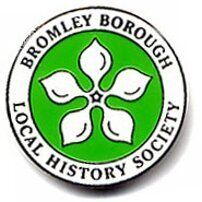Bromley Borough Local History Society
Registered Charity
No. 273 963

Bromley Borough Local History Society
We met by the northern entrance to the Park where, on the ground, can be seen a plaque commemorating the purchase of the Park in 1913, or more correctly its opening as it was actually bought in 1911 with the aid of a government grant. In the background, can be seen "Kelsey Corner", the house built by Hooper in 1910. He lived here until his death in 1938 having previously moved from his house in Wickham Road to Albemarle Road.
This is Kelsey Corner, glimpsed in the previous photo, and shows it is built in the Arts and Crafts style with harled walls and pretty cottage details.
Hooper's first work was along Wickham Road, with a series of 13 houses, all different, and the grandest survivor is this imposing house, Cedar Lawn (no. 76), with a picturesque massing reflecting Norman Shaw’s Olde English style. Extracted from Doug's notes and photos is a picture of the man himself. Sadly, his own house further along the road, where he moved in 1891 with his new Beckenham bride, Louisa Glover, has been demolished.
These are the two other Hooper houses on the same road which have escaped destruction and seriously disappointing replacements!
Largely unaltered (although the blue stucco at No. 72 is not original), it is interesting to examine the houses in detail because initial impressions of basic patterns are replaced by admiration for the details they incorporate. No. 74 below is asymmetrical with an excellent composition of tile hanging, elegant chimney stacks and an ornate timber porch. This property, although beautifully maintained, is not listed.
No. 72 is symmetrical at first glance with its canted central oriel over the porch. However, on closer inspection the placing of the front chimney stack and the use of bay, oriel and dormer detailing gives a layer of charming individuality.
Our walk returned to Kelsey Park where, beyond the lake the we could see the site of Kelsey Manor. An earlier structure which had served the approximately 200 acre estate was demolished and a truly gigantic and fearsomely Victorian gothic building erected in its place at the behest of the Hoare banking family. They made little use of it, however, and it changed hands and use on several occasions, including time as a nunnery, a girls school and finally a wartime barracks. It was demolished just after the First World War by which time, of course, the surrounding land had been sold off and widely developed.
Little remains to show the former glories of the estate but tucked away in the woods on the east side of the park is the ice house, the top of which can be seen. It dates from the earlier estate, probably having been built in the 18th or early 19th century. It is built in brick and has a domed top with the entrance just visible on the left. Internally it is likely to have a domed bottom terminating in a drain.
For obvious reasons it is not accessible today and, although Listed, is subject to damage, both human and environmental.
Probably part of the new estate, and dating from the mid 19th century is the Gate House on Wickham Road, now a private residence.
Although it appears older, its age is given away by the grey industrial bricks adjacent to the ground floor windows. However, it has a nicely carved oak porch!
Our tour ended in Manor Way (named after Kelsey Manor which was on this road) at the Bailiff’s Cottage, a grade II listed vernacular house with Gothic style timber windows.
Our thanks to Doug Black for his most entertaining tour and for all the fascinating detail he provided about Kelsey and its history.